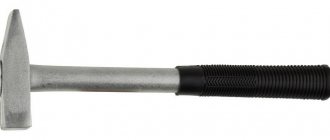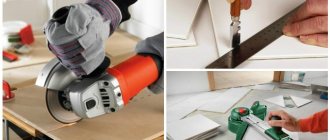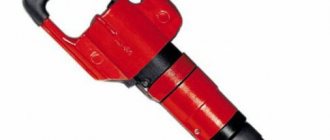A crowbar nail puller is a convenient device for removing nails from various structures. It makes it much easier for the technician to carry out dismantling work. Helps resolve the issue of removing nails quickly and efficiently. In turn, this is an ergonomic tool, despite the fact that it belongs to the category of a manual device, there are also models of an electric nail puller
If you pay attention to the photo of a nail puller, you can understand that this tool is a curved wedge with a forked end, with the help of which the head of the nail or other element being removed is captured. It is made exclusively from high quality metal and has a long shoulder.
Features of nail pullers
At first glance, it may seem that a nail puller is an ordinary crowbar; there is nothing special about it, despite the rather wide area of use of this device.
However, the instrument itself has many modifications and varieties. The nail puller is a lever-wedge tool; due to the peculiarities of its shape, it can be used to easily pull nails out of virtually any surface.
It can be used in conjunction with hammers, crowbars and other tools to increase efficiency.
Application
The nail puller is used for a number of household jobs:
- indoor renovation;
- deformation of wooden and metal structures;
- removing nails from any surface.
If there are any modifications, additional functions are added to the classic nail puller. They are used depending on what modification is presented: hammer, crowbar, pry bar, and so on.
Reference! When operating a nail puller, it is important to follow safety precautions and take care to protect your eyes, fingers, legs and skin.
Advantages of nail pullers
The nail puller has a number of advantages that are often not considered.
- Both manual and electric models of this tool are available for sale.
- It can be used not only for industrial purposes and on construction sites, but also at home
- Compact and convenient, extremely easy to use
- Has a wide range of uses and high efficiency
Today, you can purchase this tool in virtually any specialized store, choosing a suitable modification from several dozen presented.
It can be used not only for its intended purpose, pulling nails out of surfaces. It can also be used for driving nails and carrying heavy loads, since the tool is made of very strong alloys.
The biggest advantage of this tool is its versatility and availability coupled with a low price.
Usage
First of all, this tool is used by builders and installers. With this device, old floor boards are torn off, wall paneling is torn off, and the slate roof is dismantled. They dismantle wooden fences.
Compared to crowbars, the nail puller is distinguished by its compactness. Thanks to this, it can be used to destroy brickwork. The shovel is pushed under the brick and pulled off the wall with a lever. The device is also used by loaders and couriers who deliver lathed cargo. A nail puller can replace a hammer, which you may not have at hand.
Nail puller device
You can even find a classic nail puller at home. It is designed as a complementary element to a regular hammer. It is represented by one of the two branches of the hammer head wedge. The handle is usually made of wood. This nail puller is designed for everyday tasks that it can perform, for example, during repairs.
You can also find models made entirely of metal. They are more durable and reliable, and also cost a little more.
Electric models are not very common because they are quite expensive and can only be found among highly specialized craftsmen.
However, there is no need for this model in everyday life. The principle of operation is as simple as possible: the working surface, represented solely by a wedge for pulling out nails, is connected to a small battery located in a metal case using a wire.
How to make a nail puller with your own hands
How to make a nail puller yourself with your own hands? Let's look at the step-by-step instructions:
- Blank nozzle
You need steel wires of various diameters, for small nails - 0.5 millimeters. You can even use rebar for heavy duty work. Treat the tip. Next, you need to flatten the end with a hammer on an anvil. Using a regular hacksaw, you need to cut a slot of a certain depth.
- Nozzle processing
Use a file and finish the edges. Remove all existing nicks, irregularities and other defects. Bend the nozzle in two steps. To begin, bend the thick part of the wire. Then the part that is located closer to the working area is bent.
- Usage
All that remains is to install the tip on the handle and use it.
Types of nail pullers
As mentioned above, today there are a large number of varieties of this instrument, all of them are freely available. Let's look at each of them separately, give its advantages and the main functions that it performs.
Classical
The classic look is the simplest and most common. It is quite sufficient for removing nails from all surfaces, quickly dismantling coatings and wooden buildings, as well as for carrying heavy loads due to the use of durable alloys.
- A classic nail puller is quite small, no more than 40 cm long.
- It may have a wooden handle or be a solid metal tool.
- In some configurations the handle is rubberized.
- This is done for convenience so that your hands do not slip off the tool during operation.
Scrap
This variety belongs to the combined subcategory, because it actually combines more than one instrument. As a rule, such models have a nail puller at one end, a classic curved tool.
And at the other end there is an ending ground off on one side. It is necessary for dismantling structures, mainly made of wood, and can also be used to open steel doors with their subsequent deformation.
This type is suitable for virtually any work that may occur on site, since it has a one-piece device made of reliable metal, and at the same time has enormous functionality and relative lightness.
Hammer
This variety is considered the most popular due to its compactness and accessibility. In this case, the nail puller is located on the opposite side from the striking side of the hammer and performs an auxiliary function.
The greatest popularity of this particular variety is due to its accessibility and compactness.
In addition, such a tool is quite capable of performing all the work that involves home repairs, this is quite enough.
Ticks
This is one of the oldest types of nail puller. In fact, it is a metal pliers; the work is carried out in the same way as using pliers.
- The working surface grabs the nails and then pulls them out.
- This model is even smaller than the previous one, but due to the lack of leverage it is less convenient
- . It also has a pneumatic variation, but it is quite rare.
Mount
One of the most expensive types of nail puller. However, this is what professionals prefer to use. This is because it can replace a crowbar, a hammer, a nail puller and a chisel, or a unit for bending rods.
Such a tool is capable of coping with a large volume of diverse work. However, it is worth considering that in terms of strength, this model is slightly inferior to the classic crowbar-claw puller, because it is made from a slightly different alloy, which is less reliable.
Recommendations
In order to choose the right tool model, you need to clearly understand the scope of the upcoming work and its features.
Some of the above models can be used as a universal device. But others have an extremely narrow specialization, which is also worth considering.











